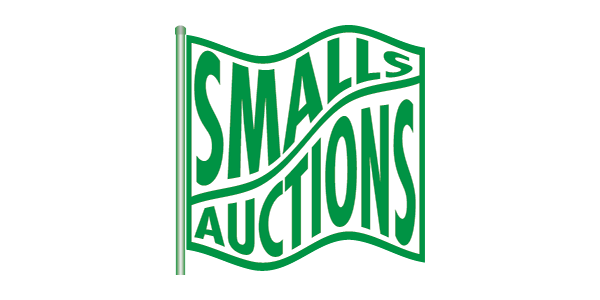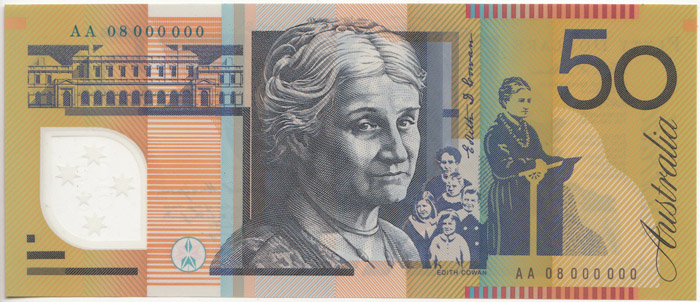Lot 284


Unique First Prefix - ex Governor's Reserve Bank Specimen Sheet
-
Literature:
- 396 Medium:
- Collectibles Circa:
- Coins, Monies & Stamps Notes:
- Through the years Australia has been party to many ground-breaking inventions that have been taken up by the world, and in this category we can certainly place ‘polymer’ of ‘plastic’ banknotes which were first tested in 1988 in Australia with the one-off Bi-Centennial Commemorative $10. The problem with paper notes had always been their relatively high production costs compared to their short life spans, and this was particularly true of the smaller denominations which were spent more often and were also more likely to be found screwed up with small change in our pockets rather than in the sanctity of a wallet. Australia was not the first nation to introduce ‘plastic-like’ notes as smaller nations such as the Isle of Man and Haiti had trialled ‘tyvek’ banknotes produced by the American Banknote Company in the early 1980s. However these trials proved unsatisfactory and folklore has it that the Isle of Man notes were often the subject of ridicule as bar-room patrons tested how far they would stretch while the Haiti notes were avoided because it was feared that they transmitted disease. Australia’s ‘polymer’ notes were successfully phased in starting with the $5 in 1992 and ending with the $100 in 1996 and this transition to ‘plastic’ has now been mirrored by many nations all around the world. Australian-style polymer notes now offer durability and remarkable security features unachievable on paper issues. Collectors of Australia banknotes would be familiar with ‘specimen’ issues of the 1988 ‘Bi-Centennial’ $10 and the polymer denominations that followed in the 1990s beginning with the AA00 000000 $5 in 1992 and concluding with the AA96 000000 $100 in 1996. As each new ‘polymer’ denomination was released hundreds of individually numbered ‘specimen’ notes but all bearing identical serial numbers were ‘loaned’ to official reference collections such as state libraries, police forces and local and international banks as well as gifted to a long list of dignitaries that were recognised for their services to the Reserve Bank of Australia, such as past Governors. Interestingly, only a few select dignitaries were given an updated $5 ‘Specimen’ when a change of colour was introduced in 1995, but examples of the new note were provided to the usual official reference collections so that they could remain abreast of design changes. It is important to realise that it is only the notes given to private individuals that can be owned and traded by collectors as the ‘specimens’ loaned to reference collections remain the property of the Reserve Bank of Australia and can be confiscated if offered for sale. The writer can well remember the 1996 $100 Polymer ‘Specimen’ loaned to the Bank of England, whose sale by an embarrassed British auction house resulted in police charges for the archivist who had purloined it from the official collection. Generally the spans of the individual numbers stamped on the ‘Specimen’ notes are the giveaway as to the intended recipient i.e. a bank, police force etc. What is not widely known is that ‘specimen’ notes post 1996 are still available to collectors via odd ‘specimen’ banknote sheets that were printed each year. Succeeding Governors of the Reserve Bank of Australia followed a tradition of donating a ‘specimen’ sheet of banknotes for a charity auction conducted annually by the Australian financial services industry. The ‘specimen’ notes taken from the charity sheets, unlike the earlier ‘specimens’, carried normal prefixes and were not individually numbered but they did follow the dating system introduced in 1993 where the first two numbers after the two letter prefix indicated the year of issue which was followed by six zeros. For example the first note on the charity sheet for the 2005 $20 had a ‘First Prefix Serial’ AA05 000000 and the last DA05 000000. The production of the annual specimen sheets corresponded with the notes being printed at the time and so it was not unusual for $50 sheets for example which are the most printed denomination to feature in consecutive years. What is ‘unique ‘about all of these later ‘specimens’ is that that are individually prefixed meaning that there is only one ‘AA - First Prefix’. This month Smalls Auctions offers five ‘First Prefix’ notes from the Governor’s ‘Specimen’ sheets. The AA07 000000 & AB07 000000 $5 are exceedingly rare as not only is it a ‘unique’ ‘consecutive combination of ‘First & Second Prefixes’ but these prefixes were not used at all on the circulation notes of that year.
Accepted Forms of Payment:
American Express, MasterCard, Money Order / Cashiers Check, Paypal, Visa, Wire Transfer
Shipping
AUSTRALIA: Purchases within Australia will be charged a MINIMUM SHIPPING FEE of $5.50 and will be sent by Registered Post. Additional insurance is optional at the buyer's expense.
INTERNATIONAL: Overseas purchases will be charged a MINIMUM SHIPPING FEE of $20.00 and will be sent by Registered Post International. Additional insurance is optional at the buyer's expense.
Both Australian and International packages are traceable in transit and require a signature on delivery.
Smalls Auctions
You agree to pay a buyer's premium of up to 18.5% and any applicable taxes and shipping.
View full terms and conditions
| From: | To: | Increments: |
|---|---|---|
| A$0 | A$99 | A$5 |
| A$100 | A$999 | A$10 |
| A$1,000 | A$4,999 | A$50 |
| A$5,000 | A$9,999 | A$100 |
| A$10,000 + | A$250 |




